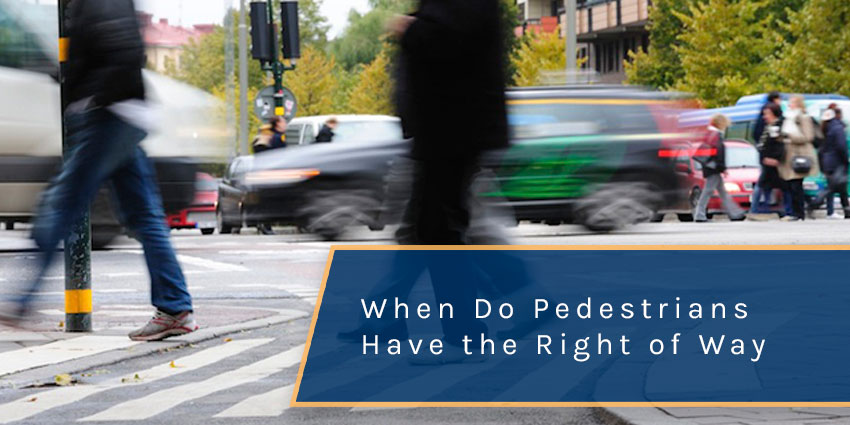St. Petersburg’s streets are buzzing with cars and people. Year-round sunshine keeps locals and tourists alike outside and enjoying the weather. From people out for a walk to joggers, rollerbladers, or bicyclists, there’s no shortage of people out and about.
While this dynamic traffic can be exciting, it can also pose challenges for pedestrians and drivers alike. With so many people moving about and in so many different ways, it increases the chances of confusion about who has the right-of-way.
You might be surprised how many crashes involve a simple failure to understand the right-of-way. Both people on foot and in vehicles have the responsibility to know when and where it’s safe to move through traffic. When this is unknown or ignored, it leads to accidents.
Accidents that involve pedestrians may result in severe injuries or even death. Knowledge about pedestrian rights and rules relative to right-of-way is essential to ensure safe roadways for everyone.
Table of Contents
Who Is Considered A Pedestrian in St. Petersburg?
In Florida, a pedestrian is defined as someone who’s, on foot or using modes of transportation like a wheelchair, skateboard, or rollerblades. However, bicycles are considered vehicles according to Florida law. Therefore cyclists have the rights and responsibilities as drivers when on roads.
Understanding the General Right-of-Way
To prioritize pedestrian safety in St. Petersburg, the general right-of-way laws apply. This means that drivers must yield to pedestrians crossing at intersections with unmarked crosswalks as per Florida’s Uniform Traffic Control Law. It is crucial for motorists to exercise caution and avoid any collisions with pedestrians on any road.
How Common Are Accidents Involving Pedestrians in Pinellas County?
In 2023, the statistical data concerning pedestrian accidents in the picturesque Pinellas County of sunny Florida is sure to catch one’s attention. It is regrettable to note that 402 crash incidents involving pedestrians have transpired throughout the year, prompting a call for increased caution and safety awareness within the community. What’s more lamentable, 33 of these resulted in fatalities. Although these figures paint a disheartening picture, it is essential to approach them as an opportunity for collective introspection and committed action.
While it is crucial to acknowledge these distressing statistics, it is equally important to underscore the significance of preventive measures and a proactive mindset when navigating the county’s roadways. Educating oneself about pedestrian safety protocols, heightening one’s situational awareness, and advocating for enhanced infrastructure designed with pedestrians in mind are vital steps toward combating this recurring issue.
What Are the Most Dangerous Types of Pedestrian Crossings?
Interactions between pedestrians and vehicles occur frequently in ways every day. Here are some important types of pedestrian crossings that should be paid attention to for safety:
Unmarked Crosswalks
Any intersection is a crossing point for pedestrians. When there are no signs or pavement markings at the intersection, it’s considered an “unmarked crosswalk.” Whenever a pedestrian is already within the crosswalk or is about to enter it, a driver should yield the right-of-way.
Stop Sign Intersections
When it comes to stop sign-controlled intersections, pedestrians typically have the right-of-way. This is as long as they are lawfully crossing at the designated areas. Drivers must come to a complete stop before yielding to any pedestrians intending to cross.
Traffic Signal Intersections
Traffic signal-controlled intersections often determine who has the right-of-way for pedestrians in St. Petersburg. Pedestrians should obey signals accordingly but must always exercise caution while crossing. Drivers must yield to pedestrians crossing with a “walk” signal and refrain from turning until pedestrians have finished crossing.
Sidewalks and Alleyways
Pedestrians using the sidewalk in St. Pete generally have the right-of-way over vehicles entering or exiting driveways, parking lots, or alleyways. Drivers must stop before reaching the sidewalk and yield to pedestrians before proceeding.
School Zones and Crossings
Children’s safety is paramount in school zones. Florida law imposes lower speed limits within designated school zones, requiring increased caution from drivers. When children are present or crossing via marked crosswalks, drivers must yield the right-of-way.
Shared Pedestrian and Vehicle Spaces
In some contexts, pedestrians share the roadway with vehicles due to limited space. For instance, people may have to walk in or along the road when they are passing through construction zones or rural areas. In all such cases, drivers should still be cautious, reduce the speed, and allow pedestrians to cross on their way.
When Are Pedestrians Not Granted The Right-Of-Way?
While pedestrians have many protections and rights, they do not always have the right-of-way. Nonetheless, it should be noted that the exceptions to this rule do not reduce a driver’s obligation to drive with reasonable care. In all circumstances, caution should be taken while driving to avoid ped pedestrian accidents. This is still true even if a pedestrian does not follow the law on the road.
The circumstances where pedestrians in St. Petersburg have no right-of-way include:
Crossing Against A Signal
Foot traffic is required to obey traffic signals and pedestrian crossing signals. Pedestrians who attempt to cross a road against a “Don’t Walk” signal or a flashing red hand are in no way entitled to have the right-of-way.
Jaywalking
Jaywalking refers to crossing the road other than at a designated crosswalk or intersection. Jaywalkers do not have the right of way since they are not crossing at designated points. Unfortunately, a recent incident occurred in Pinellas County where a jaywalker was struck and killed while crossing outside of the crosswalk. Because the pedestrian did not adhere to the right-of-way rules, the driver did not face any charges as a result of this accident.
Outside Crosswalks or Intersections
Pedestrians crossing outside marked crosswalks or intersections should yield to approaching vehicles since drivers may have limited visibility and unexpected movements increase the risk of accidents.
Intoxication or Impaired Judgment
If a pedestrian is under the influence of alcohol, drugs, or any substance impairing their judgment and physical abilities, they may no longer be granted the right-of-way under Florida law.
Unlawful Entry Onto Roadways
Pedestrians who negligently or unlawfully enter roadways without regard for approaching traffic forfeit their right-of-way.
What Are Common Injuries From A Pedestrian Accident?
Pedestrian accidents can result in a range of injuries, varying in severity depending on the circumstances of the incident. It’s vital for pedestrians involved in accidents to seek immediate medical attention regardless of their perceived injuries. Additionally, consulting with an experienced St. Petersburg pedestrian accident attorney is essential to protect your legal rights and obtain fair compensation for current and future damages resulting from the incident.
Common injuries that pedestrians may sustain in accidents include:
Fractures and Broken Bones
Pedestrians are vulnerable to fractures and broken bones, particularly in the event of a collision with a vehicle. These injuries commonly affect the limbs, such as the legs and arms.
Head Injuries
The impact of a pedestrian accident can cause traumatic brain injuries (TBI), concussions, skull fractures, or other head injuries. Such injuries require immediate medical attention due to their potential long-term consequences.
Spinal Cord Injuries
Pedestrians who experience a forceful impact, such as being hit by a vehicle, may sustain spinal cord injuries. These injuries can result in partial or complete paralysis and require lifelong medical care.
Soft Tissue Injuries
Soft tissue injuries include sprains, strains, contusions, and bruises. These can be caused by sudden movements during a pedestrian accident and may lead to significant pain, swelling, and restricted mobility.
Internal Injuries
Pedestrian accidents can cause internal injuries to organs such as the liver, spleen, kidneys, or lungs. Internal bleeding is also a concern and may require immediate surgical intervention.
Emotional Trauma
Pedestrian accidents are often traumatic events that can result in emotional distress, anxiety disorders, post-traumatic stress disorder (PTSD), depression, and other psychological consequences.
Road Rash and Abrasions
Falling or being dragged during an accident can cause severe abrasions and road rash, resulting in pain, infection risks, scarring, and long recovery periods.
A St. Petersburg pedestrian accident attorney can help you in several ways:
How Can A St. Petersburg Pedestrian Accident Attorney Help?
Overall, a St. Petersburg pedestrian accident attorney can provide essential support and expertise throughout the entire legal process while fighting on your behalf to secure the compensation you deserve for your injuries and related expenses. Here are some of the fundamental ways in which your St. Petersburg pedestrian accident attorney can help you:
Legal advice and guidance
They can provide you with expert legal advice and guidance related to your specific situation, ensuring you understand your rights and the legal options available to you.
Investigation
They will conduct a thorough investigation of the accident, gathering evidence like witness statements, police reports, surveillance footage, or expert testimonies to build a strong case on your behalf.
Establishing liability
Your St. Petersburg pedestrian accident attorney will work to establish liability for your injuries, identifying who was at fault for the accident – whether it was a negligent driver, poorly maintained roadways, defective products, or other parties who may be legally responsible for the harm caused.
Negotiating with insurance companies
A St. Petersburg pedestrian accident attorney will negotiate on your behalf with insurance companies and their representatives. This will ensure you receive fair compensation for your accident. They work to make sure you’re covered for your injuries, medical bills, lost wages, pain and suffering, and other damages suffered due to the accident.
Litigation representation
If necessary, they can represent you in court, advocating for your rights and pushing for a favorable settlement or jury verdict if a fair agreement cannot be reached otherwise.
Handling paperwork and legal procedures
Filing a claim or lawsuit involves lots of paperwork and procedures, including drafting legal documents, preparing court filings, and responding to motions filed by opposing parties. A St. Petersburg pedestrian accident attorney will handle all of this necessary but complicated work so you don’t have to worry or make any mistakes.
Contact A St. Petersburg Pedestrian Accident Attorney For A Free Consultation
In the wake of a pedestrian accident in Pinellas County, it’s vital to consult with an experienced St. Petersburg pedestrian accident attorney. At our law firm, we understand the devastating impact that pedestrian accidents can have on a person and their family. We are here to steer you through the legal process and fight for your deserved compensation. Contact our St. Petersburg pedestrian accident attorneys today for a free consultation. Our dedicated team will listen to your story, evaluate your case, and provide personalized advice tailored to your situation. Don’t wait – take the first step towards justice and seek the representation you need. Call us now for expert legal assistance!














